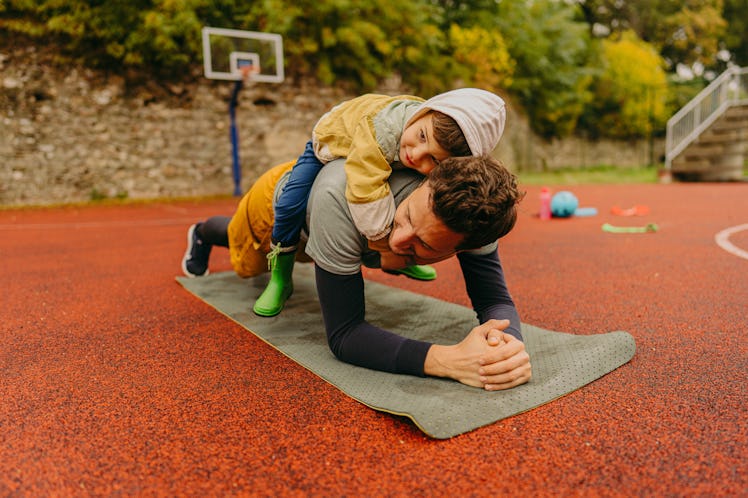Isometric Exercises To Build Your Kid-Carrying Muscles
These simple isometric exercises will increase muscle stamina to absorb the weight of a wriggling kid.

No matter how much you can curl, your arms are still going to throb after holding a 20-lb. sack of child for 20 minutes. That’s because carrying a baby is a killer test of muscle endurance. “Holding a kid requires constant muscle contraction for your biceps, shoulders, and back. And these positions impede blood flow and lactic acid removal, causing fatigue,” says trainer Chris Jordan. “It’s like the Spartan games just to maintain these positions.”
Jordan is the father of a 3-year-old, as well as Director of Exercise Physiology at Johnson & Johnson’s Human Performance Institute, where he’s responsible for the development and execution of the corporate fitness programming. Jordan says the key to building muscle endurance lies in isometric contractions — the tiny twitches that occur when muscles tense without changing length. To build up that strength, you need to perform exercises that enable you to apply stress to a muscle and joint without allowing it to contract.
Here are four simple isometric exercises Jordan maintains will not only boost your stamina, but will also make your body ready to wrangle a wriggling kid.
Muscle Group: Back & Core
Exercise: Plank Combination
Why? Carrying a tired kid around the mall means your muscles are in a state of elevated contraction.
How To Do It: Perform a standard plank for 30 seconds (place your hands shoulder-width apart on the ground and extend both legs backward as you would for a push-up; draw in your navel so you’re bracing with your abdomen and squeeze your butt). Then switch to a side-plank and hold for another 30 (shift so you’re leaning only on your right forearm, and your right hip is pointing toward the ground). Then, move to a reverse plank (butt towards the ground, heels on the floor, arms propping up your body, head towards the ceiling, core tight) for 30 seconds. Finally, switch to a side-plank, but this time lean on your left arm.
Perform two to three sets of one circuit. Work up to a minute of holding each position.
Advice: “With these exercises, it’s quality over quantity,” says Jordan. “Your body should be straight from head to heel — use a mirror to see how you’re doing. Rounding the back or shoulders, dropping your hips in regular plank, or dropping your butt on reverse plank defeats the purpose.”
Muscle Group: Shoulders
Exercise #1: ITY positions with resistance band
Why? Because you don’t want your shoulders to tremble like seismograph needles every time you hold your child. “The goal is to go to the point of fatigue,” says Jordan “Fifteen to 25 reps would be considered the best range for muscular endurance.”
How To Do It: This exercise is broken into several resistance band positions, each of which is designated by letter:
- ‘I’: Attach a resistance band or tubing to a secure door handle. Standing tall with feet slightly wider than shoulder width apart and facing the door. Grab the two handles and pull your hands to your hips. Return to starting position and repeat.
- ‘T’: Facing the door, bring straight arms up to shoulder level, palms of your hands facing the door. Return to starting position and repeat.
- ‘Y’: Facing the door, bring your arms straight above your head to form a Y. Return to starting position and repeat.
Perform 15–20 reps or more reps, 1–2 sets, with 30-second recovery between sets.
Advice: “A common mistake is to overload and do too much resistance, by positioning yourself too far away from the door or choosing the wrong grade of band, which will result in a break of form and technique,” says Jordan. “You should be strong and stable. Stabilize before you mobilize. Brace your core and keep upright with your head neutral, not protracted. Maintain that position all the way through.”
Exercise #2: Internal-external shoulder rotation
With the same band and stance as ITY, position your hands so your arms are right angles at the elbow joints. Externally rotate your shoulders to raise your hands up, bringing yourself into a double high-five position. For internal rotation, face away from the door and start in the double high-five position. Move your hands towards the ground by pushing your hands forward and down while your elbows stay in place.
Muscle Group: Biceps
Exercise: Kettlebell Kid Carry
Why? Practice makes perfect. “Twenty years ago, the British army discovered that with foundational strength and conditioning training, soldiers in the field would still struggle with their marksmanship after hiking or walking,” says Jordan. “We had them get on treadmills with their backpack and weights on, wearing military boots and holding their machine gun. After this type of mimicry training, they were able to aim and shoot at end of the event.”
How To Do It: Grab a kettlebell (or plate, or dumbbell) in hand, bend your elbows at 90 degrees, and hoist your weight high against your chest — as though you were holding a toddler. Now, walk back and forth across the gym for one minute. Switch arms and walk back. Repeat three times.
This article was originally published on